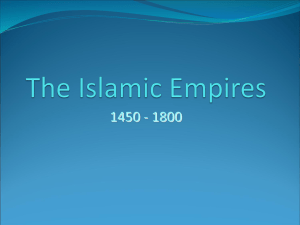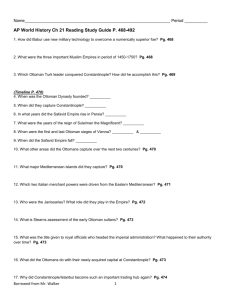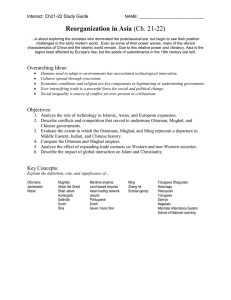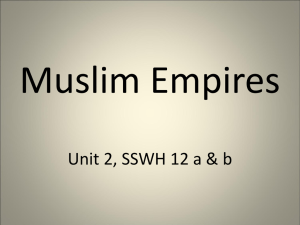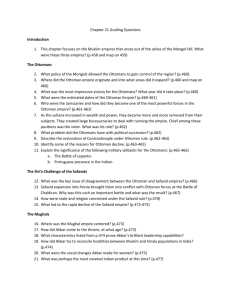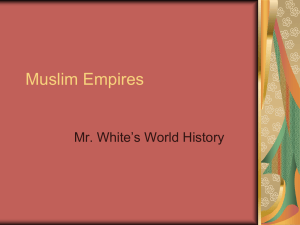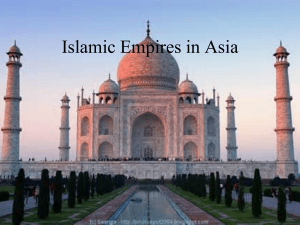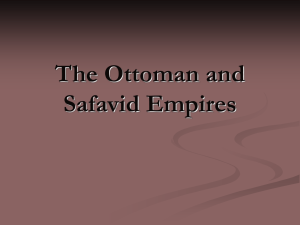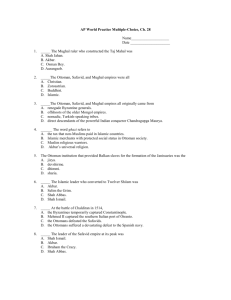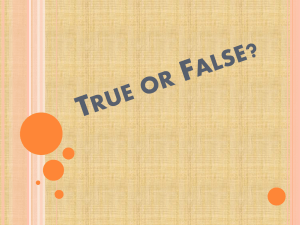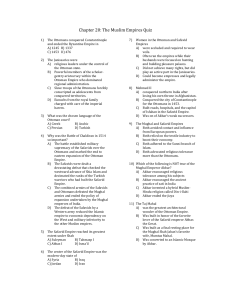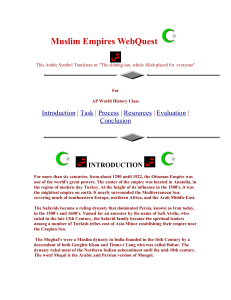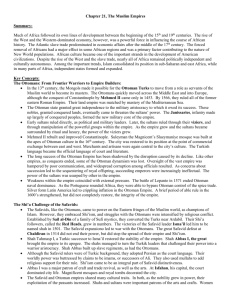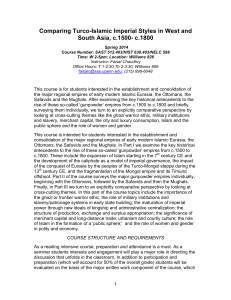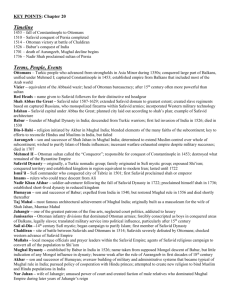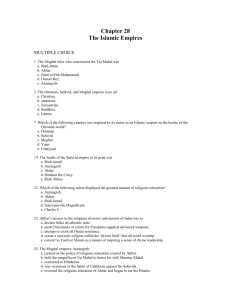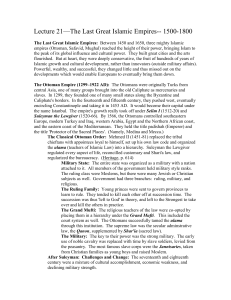I. Formation of the Islamic empires A. The Ottoman
advertisement
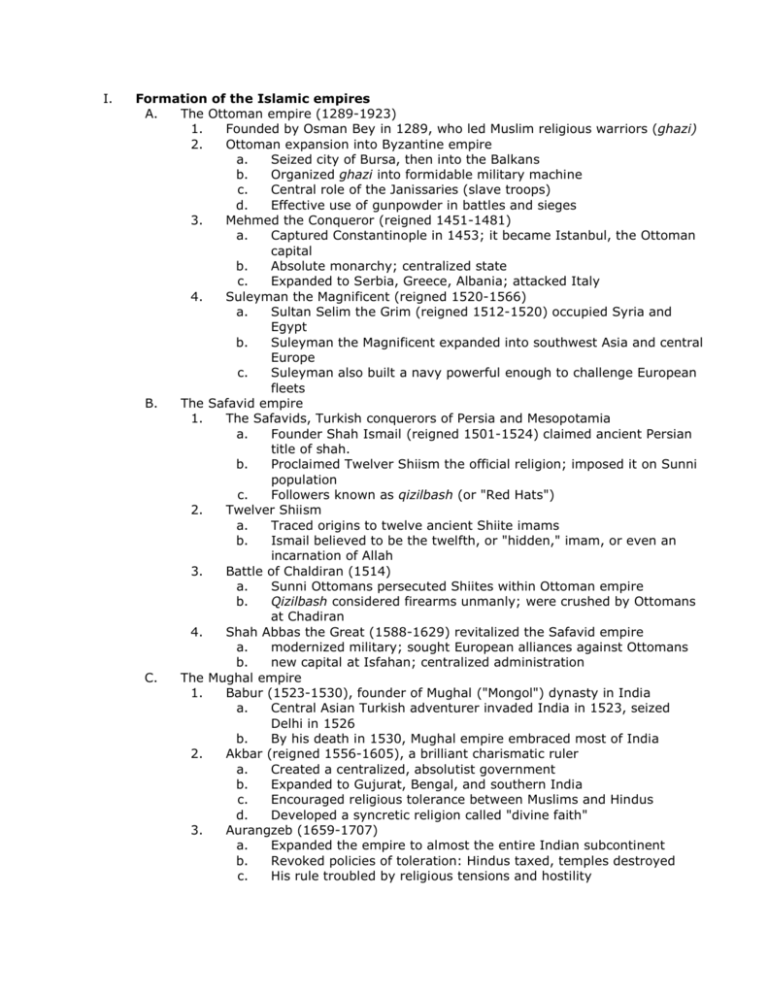
I. Formation of the Islamic empires A. The Ottoman empire (1289-1923) 1. Founded by Osman Bey in 1289, who led Muslim religious warriors (ghazi) 2. Ottoman expansion into Byzantine empire a. Seized city of Bursa, then into the Balkans b. Organized ghazi into formidable military machine c. Central role of the Janissaries (slave troops) d. Effective use of gunpowder in battles and sieges 3. Mehmed the Conqueror (reigned 1451-1481) a. Captured Constantinople in 1453; it became Istanbul, the Ottoman capital b. Absolute monarchy; centralized state c. Expanded to Serbia, Greece, Albania; attacked Italy 4. Suleyman the Magnificent (reigned 1520-1566) a. Sultan Selim the Grim (reigned 1512-1520) occupied Syria and Egypt b. Suleyman the Magnificent expanded into southwest Asia and central Europe c. Suleyman also built a navy powerful enough to challenge European fleets B. The Safavid empire 1. The Safavids, Turkish conquerors of Persia and Mesopotamia a. Founder Shah Ismail (reigned 1501-1524) claimed ancient Persian title of shah. b. Proclaimed Twelver Shiism the official religion; imposed it on Sunni population c. Followers known as qizilbash (or "Red Hats") 2. Twelver Shiism a. Traced origins to twelve ancient Shiite imams b. Ismail believed to be the twelfth, or "hidden," imam, or even an incarnation of Allah 3. Battle of Chaldiran (1514) a. Sunni Ottomans persecuted Shiites within Ottoman empire Qizilbash considered firearms unmanly; were crushed by Ottomans b. at Chadiran 4. Shah Abbas the Great (1588-1629) revitalized the Safavid empire a. modernized military; sought European alliances against Ottomans b. new capital at Isfahan; centralized administration C. The Mughal empire 1. Babur (1523-1530), founder of Mughal ("Mongol") dynasty in India a. Central Asian Turkish adventurer invaded India in 1523, seized Delhi in 1526 b. By his death in 1530, Mughal empire embraced most of India 2. Akbar (reigned 1556-1605), a brilliant charismatic ruler a. Created a centralized, absolutist government b. Expanded to Gujurat, Bengal, and southern India c. Encouraged religious tolerance between Muslims and Hindus d. Developed a syncretic religion called "divine faith" 3. Aurangzeb (1659-1707) a. Expanded the empire to almost the entire Indian subcontinent b. Revoked policies of toleration: Hindus taxed, temples destroyed c. His rule troubled by religious tensions and hostility II. Imperial Islamic society A. The dynastic state 1. The emperors and Islam a. All three Islamic empires were military creations b. Authority of dynasty derived from personal piety and military prowess of rulers c. Devotion to Islam encouraged rulers to extend their faith to new lands 2. Steppe traditions a. Autocratic: emperors imposed their will on the state b. Ongoing problems with royal succession c. Ottoman rulers could legally kill his brothers after taking the throne 3. Royal women often wielded great influence on politics B. Agriculture and trade 1. Food crops the basis of all three empires a. Major crops: wheat and rice b. Little impacted by new American crops c. Imports of coffee and tobacco very popular 2. Population growth in the three empires less dramatic than in China or Europe a. Significant population growth in India from more intense agriculture b. Less dramatic growth in Safavid and Ottoman realms 3. Long-distance trade important to all three empires a. Ottoman and Safavid empires shared segments of the east-west trade routes b. Safavids offered silk, carpets, and ceramics to European trading companies c. The Mughal empire less attentive to foreign or maritime trading d. Mughals permitted stations for English, French, and Dutch trading companies C. Religious affairs in the Islamic empires 1. Religious diversity created challenges to the rule of the empires 2. Religious diversity in India under the rule of Akbar a. Portuguese Goa was the center of Christian missions b. Jesuits welcomed at court of Akbar, but he was not interested in an exclusive faith c. Akbar tolerated Sikhism, a new faith combining elements of Hinduism and Islam d. Advocated syncretic "divine faith," emphasizing loyalty to emperor 3. Religious minorities generally tolerated in Islamic states a. In Ottoman empire, conquered peoples protected, granted religious and civil autonomy in their own communities b. In India, the Muslim rulers closely cooperated with Hindu majority c. Under Aurangzeb: Islam proclaimed official state religion, nonbelievers taxed D. Cultural patronage of the Islamic Emperors 1. All three sponsored arts and public works: mosques, palaces, schools, hospitals 2. Istanbul, the Ottoman capital, a bustling city of a million people a. Topkapi palace housed government offices and sultan's residence b. The Suleymaniye blended Islamic and Byzantine architectural elements 3. Isfahan, Safavid capital, the "queen of Persian cities" 4. Fatehpur Sikri, Mughal capital, created by Akbar a. Combined Islamic style with Indian elements b. Site abandoned because of bad water supply c. The Taj Mahal, exquisite example of Mughal architecture III. The empires in transition A. The deterioration of imperial leadership, the sixteenth to eighteenth centuries 1. Dynastic decline caused by negligent rulers, factions, and government corruption 2. Tensions increased when religious conservatives abandoned policies of tolerance a. Ottoman conservatives resisted innovations like the telescope and printing press b. In Safavid empire: Shiite leaders urged the shahs to persecute Sunnis, non-Muslims, and even the Sufis c. In Mughal India, Aurangzeb's policies provoked deep animosity of Hindus B. Economic and military decline 1. Strong economies in sixteenth century; stagnated by eighteenth century a. End of territorial expansion; difficult to support armies and bureaucrats b. Series of long and costly wars c. Officials resorted to raising taxes or corruption to deal with financial problems d. Failure to develop trade and industry; lost initiative to European merchants 2. Military decline a. Importing European weapons only promoted European weapon industries b. Imported arsenals outdated c. Ottomans even purchased military vessels from abroad C. Cultural insularity 1. Cultural conservatism a. Ottoman cartographer, Piri Reis, gathered together European maps b. Muslims seldom traveled to the West, confident of their superiority c. Ignorant of European technological developments--hostile to telescope, 1703 2. Resistance to printing press a. Introduced by Jewish refugees to Anatolia, late fifteenth century b. At first, Ottoman authorities banned printing in Turkish and Arabic c. Ban lifted in 1729, but conservatives forced closure of a Turkish press in 1742 d. In India, Mughal rulers showed little interest in printing technology 3. Foreign cultural innovations seen as a threat to political stability The Islamic Gunpowder Empires: Ottoman, Safavid, Mughal Common Elements: Nomadic Turkish conquerers Muslim piety a sign of legitimacy (Sufi influence on leadership) Autocratic rule Imperial family politics often involved deadly competition Influence of women within the Imperial family in spite of lack of public power for women Use of jizya tax on dhimmi (protected non-Muslim) populations Decline: Entrenched aristocracy replaces meritocracy. Religious tension: conservativism Economic “peripheralization”; loss of tax revenues Cost of warfare and bureaucracies Failure, sometimes deliberate, to maintain technological development "Cultural Insularity" and tendency towards chauvinism Founding Islam Origin Largest Expanse Significant Dates Military Institutions Great Leaders Ottoman 1289 - Osman Bey Sunni Wahhabi (Arabian) Anatolia between Black Sea and Mediterranean Yugoslavia/Greece, N. Africa, Mideast to Tigris River, Black Sea 1453 - Capture of Constantinople; renamed Istanbul ghazi "sword of God" Janissaries - devshirme slaves in the army Religious Minorities Mehmed II "The Conquerer" (r. 1451-1481) Suleyman the Magnificent (or "the Lawgiver") (r. 1520-1566) Topkapi palace Suleymaniye mosque complex (Istanbul) millet system: Christians, Jews. Exports Silk, Spices Vices End Tobacco, Coffee End of World War I (1919) Cultural Monuments Safavid 1501 - Shah Ismail (r. 1501-1524) Twelver Shiism Sufi Iran (Tabriz) Mughal 1526 - Babur "the Tiger" (r. to 1530) Akbar's "divine faith" Aurangzeb: Sunni N. India (Kabul/Qandahar) Central Asia, from Tigris river Most of India, except southern tip to Gandahar, Caspian Sea to Persian Gulf and Indian Ocean 1514 - Battle of Chaldiran (vs. Ottomans) qizilbash ("red hats or heads") "slaves of the royal household" Akbar (r. 1556-1605) Shah Abbas "the Great" (r. 1588-1629) Aurangzeb (r. 1659-1707) Isfahan (capital city) Taj Mahal (c. 1650) Zoroastrians, Jews, Christians Toleration varies: Hindus, Jains, Zoroastrians, Christians, Sikhs Pepper, jewels, metal craft goods Silk, carpets, ceramics, crafts 1722, mostly absorbed by Ottomans late 18c, mostly absorbed by British
